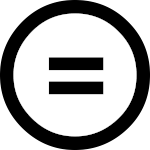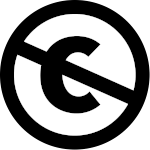Creative Commons
Creative Commons licenses let people share their work with the world, and set some rules about that sharing. This page explains how the licenses work, and why someone might want to use them.
Contact us with any questions you may have.
Creative Commons licenses
Creative Commons licenses are legal tools that let people who own copyrights pre-approve certain uses of their works. They can be helpful for creators who want their works widely used, and they can be helpful for people who want to find things that are free to use with clear permissions.
The Copyright Information parts of this website are a good example of how Creative Commons licenses make it easy to find free things to use, and easy to share your own works. For example, most of the illustrations here are used under a Creative Commons Attribution-NonCommercial (CC BY-NC) or Attribution (CC BY) license. We don't have to consider permission, or payment, or even have to think about fair use - we just know our use is okay! The Copyright Information part of this website is also shared itself under a Creative Commons license, so you may be able to copy or adapt this information.
Creative Commons licenses are developed and maintained by the Creative Commons organization. The licenses are not an alternative to copyright - they are an option for sharing works, and they rely on copyright - only a copyright owner, or someone authorized by an owner, can make a work available under a Creative Commons license.
License elements
Creative Commons licenses are made up of a few main pieces, called "elements". Creators can choose the combination of elements that make the most sense for them.
Attribution - BY

Attribution - BY - "you can use my works, but you must provide attribution."
NonCommercial - NC

NonCommercial - NC - "you can use my works, but only for noncommercial purposes."
No Derivatives - ND

No Derivatives - ND - "you can use my works, as long as you do not change them."
ShareAlike - SA

ShareAlike - SA - "you can use my works, but if you remix, transform, or build upon the material, you must distribute your contributions under the same Creative Commons license as the original."
Only the Attribution element can stand on its own as a full license; the others only work in certain combinations. The current full set of Creative Commons licenses includes BY, BY-NC, BY-ND, BY-SA, BY-NC-ND, and BY-NC-SA. Learn more about the details of these licenses from the Creative Commons organization.
Related tools and labels
CC Zero

The Creative Commons organization also makes a tool for creators who want to give up or "waive" all their rights in their works - this lets anyone use it, with no limits. This tool is called the Creative Commons Public Domain Dedication tool, or "CC Zero". Like the licenses, this is a legal tool, and applying it to a work changes things about how people can legally use that work.
Public Domain Mark

The Creative Commons organization also created a label that can be used identify works where there is no copyright - that is, works that are already in the public domain. This label is called the Public Domain Mark. Unlike the licenses or the CC Zero tool, this is NOT a legal tool, and it does not change anything about how people can legally use the work. The Public Domain Mark is a way for people to say "this is already okay for anyone to use".
There is another set of labels that describe information about the copyrights in works in museum and library collections, called "Rights Statements". They look a little bit like Creative Commons licenses, but they are more like the Public Domain Mark - they are not legal tools, and do not change how people can legally use the work. They are just helpful ways of sharing more information about copyrights.
More information
- Creative Commons' Frequently Asked Questions about the CC0 Tool
- Creative Commons' Frequently Asked Questions about the Public Domain Mark
Benefits of sharing your work
Most of the time, you own the copyright in works you create, from the moment you create them. That means that you get to make the decisions about whether, when, and how you share your work with the world. Creative Commons licenses offer options for sharing your work very widely.
Attribution
U.S. Copyright law does not usually care much about attribution or correct citation - but with a Creative Commons License, you receive attribution as a condition of all of the licenses. Note that the CC0 tool allows use without credit.
Visibility and spread
Works that are widely available get wide use! Creative Commons licenses allow your work to spread farther by making it clear that re-use is encouraged.
Enabling "good" uses
Any online distribution exposes your creative work to a lot of potential users; but also involves giving up a little control over that work. While some people reuse whatever they want without thinking about copyright, but others do think carefully about copyright, and avoid reusing works without permission. Creative Commons licenses let you indicate to those thoughtful, careful users (like teachers! and librarians!) that you do want your works to be used.
Saving time
Processing permissions requests can take time for a copyright holder, and definitely takes time on the side of the person requesting permissions. If there are many users to whom you'd always say "Yes," a Creative Commons license may save you, and your users, a great deal of time.
Complications of Creative Commons licenses
Licenses evolve
The Creative Commons licenses have changed over the years - the current version of the licenses is 4.0, but previous versions have had slightly different details.
Creators who want to share a new work with a Creative Commons license should check to see if there are any changes to the license provisions. This will help make sure the licenses line up with the creator's goals in sharing.
Users may need to check the specific terms of a specific version of a license. Especially if you see a number lower than 4.0, there might be some differences in what users can do with an older license.
Licenses are "irrevocable"
Creative Commons licenses are irrevocable: they can't be revoked or "taken back" once someone is relying on them.
Creators may change their minds about sharing a work with a Creative Commons license. They can always stop making new copies available with a Creative Commons license, but they cannot stop anyone from relying on the old license. For example: an author who had a Creative Commons license on their book last year could take the license statement off of new copies this year. But if a reader already has a copy with the Creative Commons license on it, the reader could rely on the license to make copies for a class or for friends.
Users don't have to worry that the license will change while they're using the work. The owner could stop making new copies available with the license on them, but the old license will still work. It is a good idea to make a record of the license when you start relying on it - for example, saving a PDF or screenshot with the license visible. That can help keep it clear what the license was when you started using it.
For example: a teacher who made a video last year with Creative Commons-licensed background music does not have to worry if the musician stops putting the Creative Commons license on their new tracks - or even if they take it off the music the teacher already used. Because the license can't be revoked, the license that existed last year is still good this year, and in the future. Saving a screenshot of the musician's website with Creative Commons information might help the teacher feel even more secure, if the musician ever decides to change their license terms.
Licenses do allow other kinds of use
All Creative Commons licenses explicitly preserve, and do not override existing copyright exceptions and limitations like fair use and other similar provisions. Both creators and users should know this. For example, "No Derivatives" licenses don't block derivative uses like quotation or adaptation, if allowed by fair use. And "Non-Commercial" licenses don't block commercial uses that are otherwise allowed by law.
Licenses can't quite be passed along
Creative Commons licenses are "public licenses" - that is, they give permissions from the copyright owner (or "rightsholder") to the public. But someone who can use a work, can't automatically pass on those rights to others. Other users would have to check if the original license from the rightsholder applies to them.
For example, if a non-profit research center released a report under a CC-BY license, and the report included images available under BY-NC licenses, a later commercial user would be able to use the text of the report, but might have to approach the image rightsholders for permission to reproduce the images on the commercial user's webpage.
Even more information
- Benefits of Sharing Your Work with a Creative Commons license
- Creative Commons' detailed comparison and info on the various versions of the licenses (fairly technical)
- Creative Commons' long list of Frequently Asked Questions (very readable, less technical)
How to give attribution
Many people think there are clearly defined legal rules about attribution or citation, and copyright. In the U.S., most of the time, that's not true. Although there are a lot of very detailed style rules around academic citation formats, these are not legal rules. Most rules about citation or attribution are just shared values within user groups.
Creative Commons licenses do have some legal rules around attribution! When you use a work via its Creative Commons license, you have agreed to a legal contract that requires you to give some minimum attribution. But Creative Commons rules are more flexible and less specific than a lot of academic citation rules.
Basic elements of Creative Commons credit
- The creator's name (or other form of identification, like a website username)
- The work's title (not required in most recent, CC 4.0 licenses)
- The Creative Commons license through which you are using it.
- An indication of changes or alterations you have made, if any
- Relevant links, if possible
Making the basic elements work for you
There is not a specific order or form for how these elements must appear. You simply have to do your best to give them in some kind of reasonable form.
You can use an academic citation to meet Creative Commons attribution rules. Most academic citation styles have to be modified a little bit to include the basic CC attribution elements.) You could also include less formal attribution, or consider journalistic citations as another option.
Sometimes it makes sense to show attribution right at the moment of use (for example, using an image caption on a presentation slide). But it can also make sense to give attribution in another way (for example, on a "credits" slide, or in the (linkable) text information accompanying an online video.)
Licensors (the person or people who gave the license - often the creators) can request that attribution take a particular form. For example, a company might be the rightsholder for a research paper, but might request that attribution to a few people within the company who created the paper.
Licensors can also request that they remain anonymous. Then correctly following the Creative Commons license may involve indicating why you are not providing credit.
Examples
An instructor uploads an article to share with students on a course website. Demonstrating academic citation styles, the article might appear on the reading list as follows:
Halsey, L. G., Watkins, D. A. R., & Duggan, B. M. (2012). The Energy Expenditure of Stair Climbing One Step and Two Steps at a Time: Estimations from Measures of Heart Rate. PLoS ONE, 7(12), e51213. doi:10.1371/journal.pone.0051213. Copies provided via a Creative Commons Attribution (CC-BY) license.
An image appears in a newspaper article. The image may be credited in a caption (better), or at the end of the page (good) as follows:
Red substance in half-filled test tube by Horia Varlan. Used under a CC-BY 2.0 license.
More info and examples
- Best Practices for Attribution from the Creative Commons wiki - several good examples
- A detailed comparison of differences in attribution requirements across different versions of the Creative Commons licenses